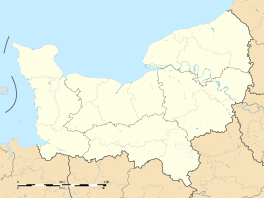Amblie
| Amblie | |
|---|---|
 |
|
| Coordinates: 49°17′32″N 0°29′09″W / 49.2922°N 0.4858°WCoordinates: 49°17′32″N 0°29′09″W / 49.2922°N 0.4858°W | |
| Country | France |
| Region | Normandy |
| Department | Calvados |
| Arrondissement | Caen |
| Canton | Bretteville-l'Orgueilleuse |
| Intercommunality | Orival |
| Government | |
| • Mayor (-) | - |
| Area1 | 5.82 km2 (2.25 sq mi) |
| Population (2014)2 | 273 |
| • Density | 47/km2 (120/sq mi) |
| Time zone | CET (UTC+1) |
| • Summer (DST) | CEST (UTC+2) |
| INSEE/Postal code | 14008 /14480 |
| Elevation | 2–53 m (6.6–173.9 ft) (avg. 25 m or 82 ft) |
|
1 French Land Register data, which excludes lakes, ponds, glaciers > 1 km² (0.386 sq mi or 247 acres) and river estuaries. 2Population without double counting: residents of multiple communes (e.g., students and military personnel) only counted once. |
|
1 French Land Register data, which excludes lakes, ponds, glaciers > 1 km² (0.386 sq mi or 247 acres) and river estuaries.
Amblie is a former commune in the Calvados department in the Normandy region of northwestern France. On 1 January 2017, it was merged into the new commune Ponts sur Seulles.
The inhabitants of the commune are known as Ambliais or Ambliaises, alternatively Ambligeois or Ambligeoises
Amblie is located some 17 km north-west of Caen, 15 km north-east of Bayeux, and 5 km from the beaches of the Normandy landings in World War II. It is located in the middle of two valleys, those of the Thue and the Seulles, not far from the plain of Caen.
It can be accessed by the D22 road from Caen which passes through the south of the commune and continues to Creully. Access to the village is by the D35 road from Reviers in the north-east passing through the village and continuing south-west to Saint-Gabriel-Brecy. Apart from the village there are also the hamlets of Le Bout de Haut and Les Planches. Apart from a patch of forest in the west and small patches of forest at scattered points, the commune is entirely farmland.
The Seulles river forms the northern border of the commune flowing east then north to join the sea at Courseulles-sur-Mer. The Thue river flows from the south through the village to join the Seulles. The commune's floodplain (meadows and marshes), its light hillsides, and its agricultural plain provide it with rich agricultural production.
The origin of the name may be from the Latin Amblia derived from Ambo Amnes meaning "two rivers".
The origins of this small village, situated on the road of mills, are uncertain. The presence of man is old, however, as evidenced by human traces dating back to antiquity. For several centuries, the territory was attached to French nobility through two families, notable members of which were Achard de Bonvouloir and the Count of Buisson de Courson. The textile industry developed in the 19th century employing mostly women. The water mills established along the Thue operated until 1945 and treated threads for textiles as well as grain. The village, like many others, suffered severely from depopulation from the beginning of the 20th century. After the First World War Belgian farmers settled in the territory. Spared during the Second World War, even though it was very close to the landing beaches, the village assisted Caen by establishing a refugee centre for thousands of wounded victims. Integrated into the sphere of influence of Caen, the commune again suffered a rural exodus to the big city.
...
Wikipedia


